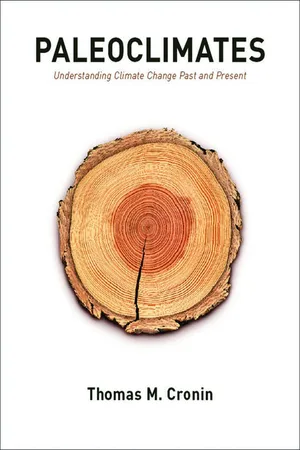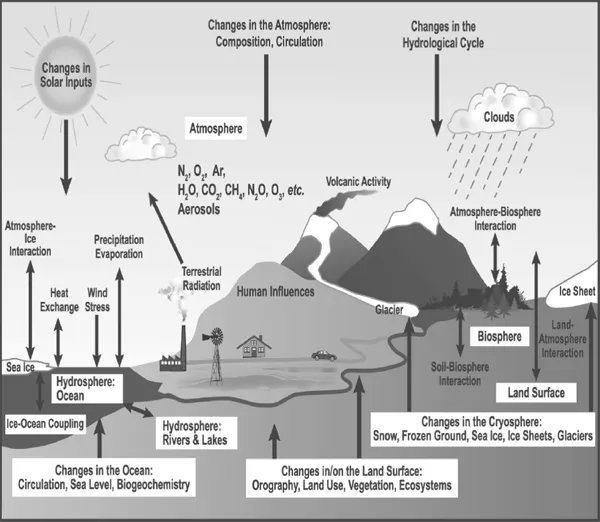![]()
Paleoclimatology and Modern Challenges
Introduction
The earth’s climate is changing in ways that raise fundamental questions about how the climate system functions, why these trends are occurring, and what future changes will occur. Atmospheric and ocean warming, Arctic Ocean sea-ice decline, Antarctic ice-shelf collapse, the retreat of alpine glaciers, the surging of ice-sheet margins in Greenland and Antarctica, extreme rainfall patterns, and ocean acidification are a few highly publicized trends. Are these trends typical of our planet? Can we say they are within the natural variability of our relatively mild interglacial climate state? Have similar events occurred in the past and, if so, why? Will they continue or even accelerate in the future?
This book describes patterns and causes of past climate change—i.e., the topic of paleoclimatology. Our main objective is to provide a context for understanding today’s changing climate and future changes predicted by climate models under elevated green house gas concentrations. The word paleoclimatology comes from the prefix “paleo,” meaning old, and “klimat,” from the Greek word for inclination or latitude. The foundations of paleoclimatology—the principles and methods on which it rests—include archives, chronology, proxies, and paleoclimate modeling.
Archives are natural features of the earth—tree rings, tropical and deep-sea corals, speleothems (cave stalagtites, precipitated calcite), ice from Greenland and Antarctica and smaller ice caps, deep-sea manganese nodules, lake sediments, wetlands, ocean sediments, geological and geomorphological features, geophysical records, and a variety of groups of organisms—that preserve clues about past climate and environmental change. Chronology involves the application of geological time, using long-term records, to date, correlate, and understand climate changes over various timescales.
Proxies are geochemical, physical, geological, and biological measurements obtained from archives. With few exceptions, like the Roda Nilometer, a record of Nile River flow near Cairo from A.D. 645 to 1920 (Hassan 1981), most observational records extend back a few decades to a century or so ago, a miniscule fraction of earth’s 4.6-billion-year history. Observations are also spatially limited, and only since the advent of satellites and remote sensing methods has the earth been monitored at a global scale. Proxies contain information about atmospheric and oceanic temperature and circulation, sea-level positions, ice-sheet and sea-ice distribution, precipitation, atmospheric chemistry, biological productivity, and other climate parameters over all timescales. Climate proxies extracted from these archives are surrogates for measurements from ground-based instruments, the satellites and tools that observe the modern system. Paleoclimate modeling involves using the synergy between proxy reconstructions and computer or mathematical models to gain insights into causes and mechanisms and to improve climate model forecasting.
Paleoclimatology has emerged over the past few decades as a major integrated field of scientific investigation devoted to the understanding of the fundamental patterns and processes of the earth’s climate over all temporal and spatial scales. This chapter introduces basic processes of the earth’s climate system, the causes of climate change, feedbacks that amplify or dampen the climate signal, and major challenges surrounding current and future climate changes needed to understand climate changes of the past. Chapter 2 in this volume describes the methods of paleoclimatology, and the rest of the chapters sequentially examine patterns and causes of climate change, moving from those occurring over hundreds of millions of years to recent changes of the past millennium.
The Earth’s Climate System
Climate is often defined as average weather conditions, the mean temperature and precipitation, atmosphere pressure, wind, etc., measured over several decades for a particular region. It represents the large-scale and long-term framework within which weather changes occur. Whereas meteorologists can predict weather from an initial condition for a few days, chaotic behavior in the atmosphere renders long-term forecasts impossible. In contrast, changes in mean climate state and variability around this mean, due to factors discussed below, are in theory predictable, at least in a probabilistic sense. A given change in solar energy, for example, will produce a range of predictable outcomes in terms of mean global surface air temperature (SAT). This fundamental premise surrounds modern climate modeling research and forecasting.
Climate changes on timescales considered in paleoclimatology, however, are not limited to changes in mean atmospheric conditions. The earth’s integrated climate system also includes the oceans, ice, lithosphere, and biosphere, which constantly interact with each other over all timescales. The major components of the climate summarized schematically in Figure 1.1 should be referred to throughout the following discussion.
Solar Radiation
We begin with a discussion of the radiation budget of the atmosphere. Except for small amounts of energy generated from the earth’s interior, solar energy drives climatic systems in the form of radiation. Solar energy reaches the atmosphere and the earth’s surface as photons in the form of shortwave radiation (∼300–1000 nm; peak wavelength is 500 nm in the visible part of the spectrum). Energy from radiation is expressed as
E = hc/λ = hv
where h is Planck’s constant (6.626 × 10−34 joules sec−1), c is the velocity of light, λ is the wavelength of radiation, and v is the frequency of the radiation.
Figure 1.2 shows the average energy balance between incoming short-wavelength solar radiation (insolation) and outgoing long-wavelength radiation measured in Watts (W) per square meter. Daytime solar radiation, called the solar “constant,” averages 1368 W m−2 sec−1 measured in a cross-sectional area at the top of the earth’s atmosphere. Importantly, this value actually varies daily, over 11-year sunspot cycles, and over longer timescales, with still poorly known implications for climate (see Chapter 11 in this volume). When the incident angle of radiation and the earth’s rotation are taken into account, the average radiation is calculated as one quarter the solar constant, or 342 W m−2. Of this total, about 107 W m−2 is reflected back to space—77 W m−2 by clouds, atmospheric gases, and aerosols (particulate material) and 30 W m−2 by the earth’s surface. Aerosols produced by human pollution have a short-term impact on reflected radiation, but explosive volcanic events eject aerosols above cloud layers and affect earth’s radiation and temperature for one to three years, depending on the event. Therefore, the contribution of volcanic activity as a climatic forcing mechanism over the last millennium must be considered to assess the contribution from anthropogenic green house gas emissions.
FIGURE 1.1 Schematic view of the components of the climate system, their processes, and their interactions. Courtesy of the Intergovernmental Panel on Climate Change (IPCC). Figure and caption from FAQ 1.2, figure 1, IPCC chapter 1, “Historical Overview of Climate Change Science” (Le Treut et al. 2007), Cambridge University Press. Courtesy of the Intergovernmental Panel on Climate Change.
The reflectivity by the earth’s surface is called its albedo. Albedo can be expressed as a unitless number between 0 (darker surface) and 1 (lighter) or as a percentage of insolation. Globally averaged albedo today is about 0.3, which means 30% of the total insolation is reflected back to space. Lighter regions of the earth’s surface (ice sheets, sea ice, snow cover, deserts) reflect relatively more radiation than dark regions (ocean surface, vegetated continents). As a consequence, changes in the earth’s surface conditions during large-scale climatic cycles, such as ice ages, and anthropogenic land-use changes influence regional and perhaps larger-scale climate change through their effect on albedo (Pielke et al. 2002).
On average, the remaining unreflected 235–240 W m−2 radiation is absorbed or scattered by various parts of the climate system, including gases in the atmosphere (mainly molecular nitrogen, N2, oxygen, O2, and ozone, O3). Each gas has its own unique radiative properties; oxygen and ozone, for example, absorb relatively more radiation at ultraviolet (shorter) wavelengths. To achieve radiative balance, the earth radiates energy back to space in the form of infrared (long) wavelength radiation because cooler bodies radiate longer wavelengths. If all absorbed energy were reflected back to space, the average surface air temperature would be about −16°C. However, some re-emitted long-wavelength radiation is trapped by atmospheric trace gases and clouds, resulting in a mean annual surface temperature of about +14°C. Water vapor (H2O) and carbon dioxide (CO2) are especially strong absorbers of infrared wavelengths, and this is why they are important green house gases.
The Hydrosphere
Many aspects of past climate changes involve the earth’s hydrosphere. The hydrosphere includes water contained in the world’s oceans (97.3%); ice sheets and glaciers (2.1%); groundwater in aquifers (0.6%); and surface water, soil moisture, water vapor in the atmosphere, and water locked up in the biosphere (<0.1%). Water in the earth’s crust is also circulated through volcanoes and hydrothermal vents via plate tectonic processes. The water cycle forms the nucleus of the global climate system, and the flux of water is controlled by processes central to paleoclimatology: evaporation (largely in tropical oceans), condensation of water vapor in the atmosphere into clouds, precipitation, snow, seaice and glacial ice formation, and cycling in the lithosphere. Water is the medium through which major and minor chemical species are circulated and transported from one part of the climate system to the next in complex biogeochemical cycles. Over millions of years, for example, chemical weathering on continents plays a critical role in global fluxes of key elements like carbon, silicon, and strontium. Over shorter timescales, regional or global hydrological balance is reflected in lakelevel oscillations that record large-scale changes in precipitation. It is essential to keep the hydrosphere in mind when viewing other parts of the climate system.
FIGURE 1.2 Estimate of the earth’s annual and global mean energy balance. Over the long term, the amount of incoming solar radiation absorbed by the earth and atmosphere is balanced by the earth and atmosphere releasing the same amount of outgoing long-wavelength radiation. About half of the incoming solar radiation is absorbed by the earth’s surface. This energy is transferred to the atmosphere by air warming in contact with the surface (thermals), by evapotranspiration, and by long-wavelength radiation that is absorbed by clouds and green house gases. The atmosphere in turn radiates long-wavelength energy back to the earth as well as out to space.
Source: Kiehl and Trenberth (1997). Figure and caption from FAQ 1.1, figure 1, IPCC chapter 1, “Historical Overview of Climate Change Science” (Le Treut et al. 2007), Cambridge University Press. Courtesy of the Intergovernmental Panel on Climate Change.
The Atmosphere
General Concepts The lower two divisions of the atmosphere, the troposphere and stratosphere, are most important for discussing climate change. The troposphere extends from the surface to a height of 10–15 km and experiences daily, seasonal, and long-term variability in temperature, cloud cover, circulation, and other features that dominate mean regional weather conditions. Stratosphere-troposphere interactions are especially important in understanding the impact of short-term changes in solar energy input.
Atmospheric circulation, like that of the oceans, involves fluid motion on a rotating planet heated by solar energy and driven by a combination of factors: pressure gradients caused by differential heating from solar radiation in low and high latitudes, and Coriolis force, caused by the earth’s rotation. Energy absorbed by oceans and continents near the equator are three times greater than that in polar regions, causing a strong equator-to-pole thermal gradient and a constant transfer of energy by atmosphere and oceans from low to high latitudes. Pressure gradients created by differential heating lead to the major features of atmospheric circulation described below.
In addition to geographical gradients in solar energy distribution, the earth’s rotation affects atmospheric circulation. Coriolis force is the deflection of objects (fluids) that are not bound by friction, resulting from the earth’s eastward rotat...



